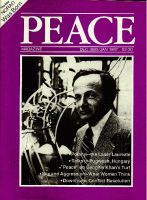
Peace Magazine Dec 1986-Jan 1987, page 41. Some rights reserved.
Search for other articles by John Bacher here
Dimitrios I. Roussopoulos Volume One: From Protest to Resistance Montréal and Buffalo: Black Rose Books, 1986. $14.95 in paperback.
The publication of Dimitrios Roussopoulos's The Coming of World War Three represents a milestone for the Canadian peace movement. Unlike previous books on the topic of peace and disarmament written by other Canadian authors, Roussopoulos writes on the basic problems confronting people concerned with building a truly international peace movement capable of turning around the drift of the two military blocs to nuclear war.
Much of what Roussopoulos writes will not please all Canadian peace activists. He describes the Canadian peace movement as one of the most narrowly focused of any western democratic nation. With the New Democratic Party supporting withdrawal from NORAD and NATO, he notes that Canada is the only country where a social democratic party like the NDP has a "more developed and radical" international affairs policy than the peace movement.
Roussopoulos describes how the European peace movement has moved from protest to resistance to be an increasingly significant force for social change. This process has been especially advanced in West Germany and Spain, where the peace movement has been revitalized by an influx of ecological activism grown out of protests against nuclear power. This, he notes, has served "to build a new disarmament movement with a fresh style and objectives that were not connected with the old left." New groups such as farmers, who were largely written off as reactionary by the traditional German left, became an important part of the peace movement.
There are fascinating details about the West German Greens and the Spanish peace movement to learn from. The Greens have organized demonstrations against Soviet SS-20 missiles and they took the bold step of organizing their own peace festival in order to allow a speaker from the Polish Solidarity trade union to take part. Likewise, many facts about Spanish peace activism are illustrated--including the huge campaign against nuclear power in the Basque area, which involved refusals to pay electricity bills, demonstrations of over 200,000 persons, and plant sabotage by workers. The comprehensive platform of the Spanish Anti-NATO Committee campaigns for Latin American solidarity, opposes nuclear power, and seeks to dissolve both military blocs.
Roussopoulos's most controversial section deals with the independent peace movements in Eastern Europe and the Soviet Union. He provides an excellent introductory account of these growing groups' challenge to militarism in the Eastern bloc and how they have been sustained by the solidarity actions of non-aligned peace activists--work largely ignored in the Western press. He connects peace and human rights in an informative section on the persecuted Turkish peace movement. The NATO-backed Turkish military dictatorship has been more repressive than Hungary's relatively liberal Communist government.
In addition to providing an insightful world tour of peace activism, The Coming of World War Three provides critical information on the danger of nuclear war in concise form-- especially true in documenting known occasions when the United States has threatened the first use of nuclear weapons. Using such impeccable sources as the memoirs of Truman, Eisenhower, and Haldeman, Roussopoulos reveals 15 nuclear threats made by the United States from 1946 to 1973. He also gives strong evidence of some 31 known U.S. near-nuclear weapons disasters. Secrecy cloaks similar chilling tales from the USSR, China, and France.

Peace Magazine Dec 1986-Jan 1987, page 41. Some rights reserved.
Search for other articles by John Bacher here